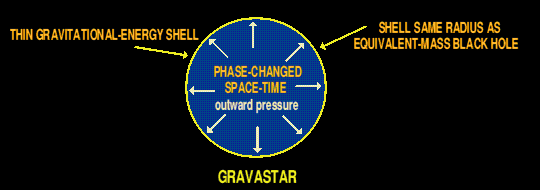

Two researchers propose that super-massive stars collapse to form a gravastar, and that Black Holes as defined above do not exist. Gravastars, it is proposed, eliminate a lot of the inconsistencies with Black Holes. When a black hole forms, all the information about the previous state of the matter (it's entropy) is eliminated, but current theory suggests black holes have enormous entropy. But a black hole possesses just three properties; mass, charge and spin. Where is this enormous entropy stored? Another inconsistency is that a photon falling into a black hole would gain an infinite amount of energy by the time it reaches the event horizon.
Instead, it is suggested, when a massive star undergoes gravitational collapse, something happens to prevent the formation of a black hole. As the gravitational field increases, the quantum fluctuations in space-time become so huge that the space-time within undergoes a kind of phase change, a bubble of this space-time forms preventing further collapse. It is a condensate, analogous to a Bose-Einsten condensate. The condensate bubble is surrounded by a thin spherical shell of gravitational energy, a stationary shock wave positioned exactly at the radius that a conventional event horizon would form on a black hole. The gravitational shock wave is trying to travel outwards at exactly the same speed as it is trying to collapse: it is stationary. The space-time condensate bubble within this spherical shell would exert an outward pressure on anything within it, thus expelling all matter to the thin gravitational shock-wave shell. Matter from outside the gravastar would be attracted to the gravastar, but if any fell past the shell, it would be pushed back to the shell. Thus the shell contains all the matter of the gravastar.
Thus gravastars are cold dense spherical shells surrounding a springy weird space within.
The researchers have shown that, like black holes, gravastars are a stable solution to Einsteins' equations. But, unlike black holes, there is no singularity where matter is infinitely dense. And because the outer shell is at the event horizon, there is no event horizon to imprison light or matter. The entropy of a gravastar would be much lower than the matter in the star that formed it, thus avoiding the excessive entropy inherent in black holes.
A gravastar formed from the collapse of a 50 solar mass star would have a gravitational shell at 150km radius (the same as for an event horizon of identical mass black hole), and the shell have a thickness equal to the Planck Length (1.6×10-35 metres). A teaspoonful of the material would weigh 108 tonnes, and it would have a temperature of 10-8 Kelvin.
But unlike a million solar mass black hole, where the event horizon would be so far away from the singularity that you could cross it without feeling a thing, as soon as you struck the shell of a gravastar (which would be at the same distance), you would be converted instantly into pure gravitational energy.
Gravastars could account for the mysterious extremely violent gamma-ray bursts that occur in the Universe; whereas the birth of a black hole from a supernova explosion would struggle to generate the required energy, the birth of a gravastar would be extraordinary violent and might shed enough energy to account for gamma-ray bursts. [It has just been observed that a magnetar only 30,000 to 50,000 light years away and in our own galaxy is responsible for at least one known source of gamma ray bursts].
![]()
![]()